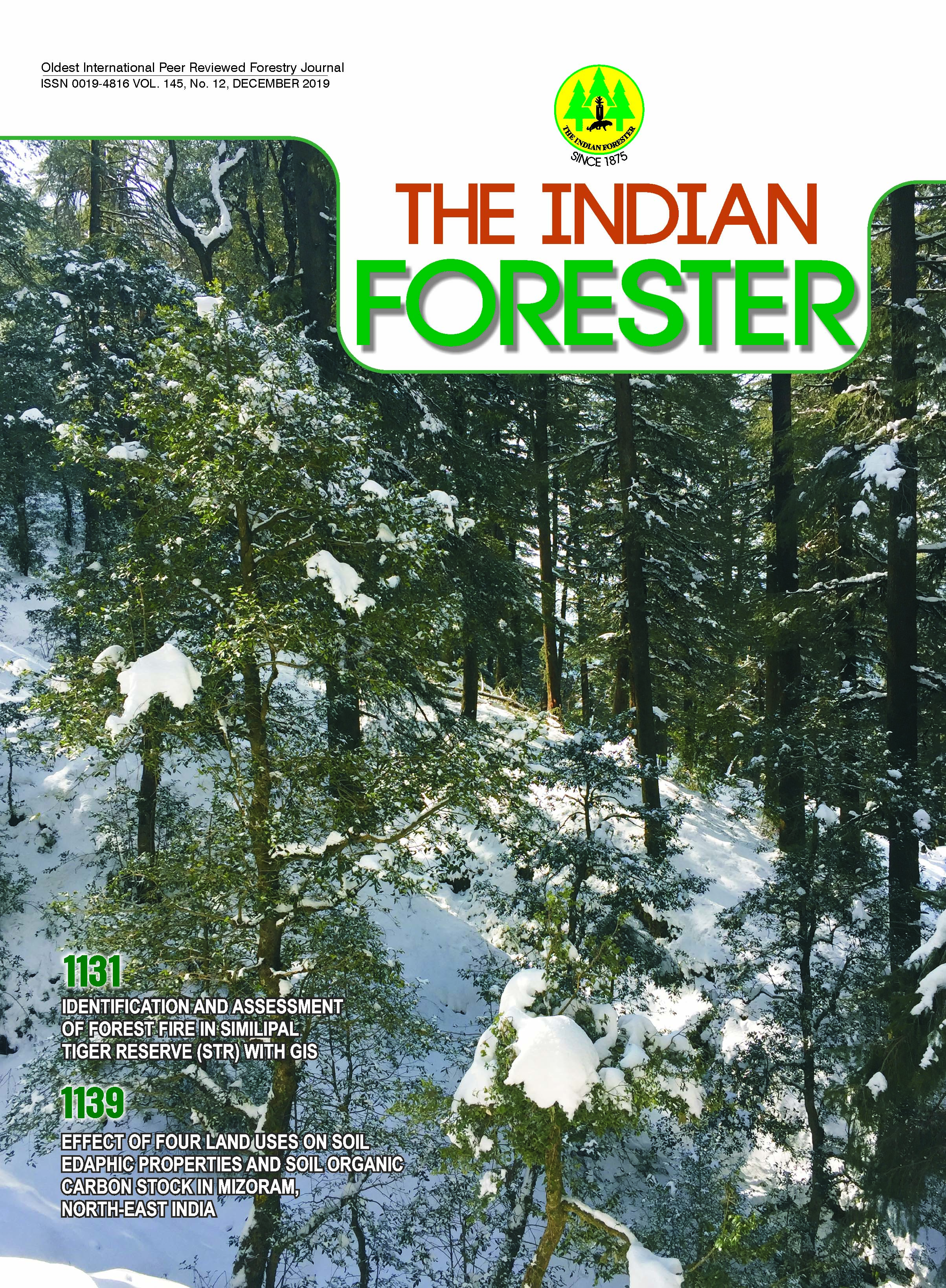Enhancing Productivity of Ailanthus excelsa Roxb. by Planting Grafted Female Trees
DOI:
https://doi.org/10.36808/if/2019/v145i12/150636Keywords:
Dioecious, Grafting, Clones, Biomass and Economics.Abstract
Ailanthus excelsa (Ardu), a dioecious tree species, is an important fodder tree of Rajasthan. It is also valued for timber, fuel-wood and ethno-medicines in many parts of India. Literature and field observations indicate that female plants of this specie exhibit better growth forms as compared to male plants. However, it is hard to identify female plants at the sapling stage. Cloning of Ardu through macro and micro-propagation methods is difficult and economically non-viable. Using grafting method developed and improved by Arid Forest Research Institute (AFRI) a trial of male and female plants was established in August 2008. The result shows that female trees are superior to male trees in all the parameters except the length of primary root. Maximum difference was observed in the leave fresh (fodder) weight and number of branches, in which 71% and 69% higher biomass was recorded in female plants, respectively.
Economics of this trial revealed that the higher cost of raising grafted female plantations is recovered within five years through fodder component only. Twenty per cent higher wood (timber and fuel) production by female plants is a benefit over plants raised through seedling with an assumption that plantations raised through seedlings have 50% male plants.
References
Allen G.A., Antos J.A. (1998). Relative reproductive effort in males and females of the dioecious shrub Oemleria cerasiformis, Oecologia, 76: 111-118.
Barrett H.C.S., Hough J. (2012). Sexual dimorphism in flowering plants, Journal of experimental botany, 64 (1): 67-82.
Chandak V.S., Jaimini S.N. (2004). Variability in Ardu (Ailanthus excelsa) In: Multipurpose tress in Tropics. IUFRO Conference 2004, Scientific Publishers (India), Jodhpur, pp. 257.
Charlesworth D., Charlesworth B., Marai G. (2005). Steps in the evolution of heteromorphic sex chromosomes, Heredity, 95: 118-128.
Cipollini Whigham, D.F. (1994). Sexual dimorphism and cost of reproduction in the dioecious shrub Lindera benzoin (Lauraceae), American Journal of Botany, 81: 65-75.
Gaur A., Singhal H., Tomar U.K. (2017). A sexual morphological differences in male and female plants of Commiphora wightii (Arn.) Bhandari - An endangered medicinal plant, Research in Plant Sciences, 5(2): 51-59.
Hoffmann A.J., Alliende M.C. (1984). Interactions in the patterns of vegetative growth and reproduction in woody dioecious plants, Oecologia, 61: 109-114.
Huang K., Liao Y., Dong T., Yang Y., He J., Huan H., Zhang Q., Xu X. (2017). Sex-specific responses of tree-ring growth to climate in the dioecious tree Populus cathayana, Journal of Plant Ecology, 11(5): 771-779, doi: 10.1093/jpe/rtx048
Jat H.S., Singh K.R., Mann J.S. (2011). Ardu in arid ecosystem: A compatible species for combating with drought and securing livelihood security of resource poor people, Ind. J. of Traditional Knowledge, 10(01): 102-113.
Jing S.W., Coley P.D. (1990). Dioecy and herbivore: the effect of growth rate on plant defence in Acer negundo, Oikos 58: 369-377.
Juvany M., Munné-Bosch S. (2015). Sex-related differences in stress tolerance in dioecious plants: a critical appraisal in a physiological context, Journal of Experimental Botany, 66(20): 6083-6092, doi.org/10.1093/jxb/erv343
Khosla P.K., Deol G.S. (1984). Growth response of male and female clones of Populus ciliata Wall. ex Royle to nitrogen fertilizer, Proc. Indian natn. Sci. Acad, 50(6): 603-606.
Kumar D., Bhat Z.A., Singh P., Shah M.Y., Bhujbal S.S. (2010). Ailanthus excelsa Roxb. is Really a Plant of Heaven, International Journal of Pharmacology, 6: 535-550.
Lloyd D.G., Webb C.J. (1977). Secondary sex characteristics in plants, Bot. Rev., 43: 177-216.
Lovett Doust J., O' Brien G., Lovett Doust L. (1987). Effects of density on the secondary sex characteristics and sex ratio in Silene alba (Caryophyllaceae), Am. J. Bot, 74: 40-46.
Nooteboom, H.P. (1962). Simaroubaceae, Flora Malasiana Series I, 16: 193-226.
Parveen Tomar U.K. (2009). In-vitro high frequency of adventitious shoots regeneration from hypocotyl segment of Ailanthus excelsa Roxb, Annals of Forestry, 17(1): 21-26.
Rajasugunasekar D., Menason E., Geetha M., Shanthi A. (2012). Randomly Amplified Polymorphic DNA (RAPD) Marker Analysis In Ailanthus excelsa, CIBTech. Journal of Biotechnology, 1(2&3): 32-37.
Roxburgh W. (1795). Plant of Coast of Coromandal. Vol.1, N. Bulmer & Company, Shakespeare Printing Office, London.
Sakai A.K., Burris T.A. (1985). Growth in male and female aspen clones: a twenty-five-year longitudinal study, Ecology, 66: 1921-1927.
Sharma N.K. (1999). In vitro and In vivo studies to develop the clonal propagation technique for Ailanthus excelsa Roxb, Ph. D. Thesis, FRI University, Dehradun.
Sharma N.K., Gupta R.K., Tomar U.K. (2008). Standardization of micropropagation technique of Ailanthus excelsa Roxb. adult tree, In: Forest Biotechnology in India (S.A. Ansari, C. Narayanan and A.K. Mandal Eds.), Satish Serial Publication House, Delhi, pp. 251-261.
Sharma N.K., Tomar U.K. (2003). Vegetative propagation of Ailanthus excelsa Roxb through stem cuttings, My Forest, 39: 299-308.
Singh U., Wadhwani A.M., Johri B.M. (1983). Dictionary of Economic Plants in India, Indian Council of Agricultural Research, New Delhi.
Tomar U.K. (2012). Development of grafting technique for clonal propagation of Ardu (A. excelsa), Chapter 4 In: Forestry in the Science of Nation, ICFRE Technologies, pp. 254-255.
Tomar U.K., Negi U., Sharma N., Emmanuel C.J.S.K. (2004). Successful grafting in Ailanthus excelsa Roxb - A brief report, My forest, 40 (1): 35-37.
Vasiliauskas S.A., Aarseen L.W. (1992). Sex ratio and neighbour effects in monospecific stands of Juniperus virginiana, Ecology, 73: 622-632.
Downloads
Downloads
Published
How to Cite
Issue
Section
License
Unless otherwise stated, copyright or similar rights in all materials presented on the site, including graphical images, are owned by Indian Forester.





